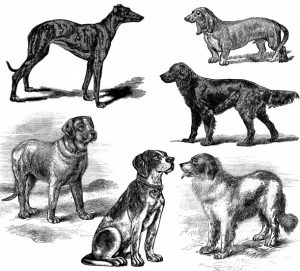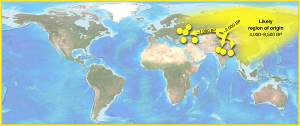The World’s Oldest Cancer, Found in Dogs
Around 6,000 years ago, a contagious canine cancer began in Asia and has since spread around the world between dogs, likely during mating. The cancer was able to travel overseas mainly due to maritime activities. Rising from one original dog and spreading to new dogs around the world, today, canine transmissible venereal tumor (CTVT) is noted as the oldest and most prolific cancer.
 The Original Dog
The Original Dog
CTVT is a histiocytic tumor that forms on the external genitalia of dogs causing discomfort and requiring surgery and chemotherapy to treat. This cancer originated in one dog and has spread endlessly, and remarkably the cells of the original dog in which the cancer arose are still present in the carrier dogs affected with CTVT. The only noticeable differences between the cells in the modern dogs and the founder dog are any spontaneous changes in the cells’ DNA due to chance or carcinogens.
The Cancer’s Global Spread
A research team, led by scientists at the University of Cambridge, has compared the tumors of 546 dogs worldwide to try to track where the disease came from, how it developed, and how it spread. Their full results were published in Science in August 2019.

Map showing the spread of the canine cancer (BP=Before Present). Credit: University of Cambridge.
According to Adrian Baez-Ortega, a PhD student on the research team, “Changes to its DNA tell a story of where it has been and when, almost like a historical travel journal.” By comparing these tumors, the researchers are able to learn a lot about the origin and development of this widely spread cancer.
From the data, the team was able to produce a phylogenic tree showing the different mutations in the tumors. From the tree, they estimate that the tumor first originated 4,000-8,500 years ago in Asia or Europe and reached the Americas around 500 years ago.
A New Carcinogen
Recent advances in technology have allowed the researchers to take this study even further. Now scientists can look at the mutations in tumor DNA and identify signatures left behind from carcinogens, for example, UV damage. Using these techniques, the researchers identified signatures for five different biological processes that mutated the tumor throughout history.
In particular, there is one carcinogen that is unknown to the researchers, as it has never been identified as a cancer-causing carcinogen. The researchers believe that this “Signature A” was a carcinogen that the tumor was exposed to thousands of years ago, maybe something present in the environment at the time, and never seen since.
Tumor Evolution
Surprisingly, there is evidence that this tumor is not suffering from positive or negative selection. Positive selection is when a mutation provides a benefit to the organism, and therefore is passed down throughout generations. Negative selection is when a mutation has a harmful impact and is less likely to be passed down.
After analyzing these tumors, there are no signs of positive or negative selection, meaning that the tumor will likely accumulate worse mutations over time. Though the cancer has been particularly successful in surviving and expanding throughout the world, this accumulation of mutations should lead to a very gradual disappearance of the cancer over time.

EFB, a canine hemangiosarcoma cell line available here.
Related Research
Do you work on canine cancer research? Kerafast offers 16 different canine cancer cell lines from the laboratory of Jaime F. Modiano, VMD, PhD, University of Minnesota, Twin Cities that you may be interested in. Here are some of the most popular ones:


